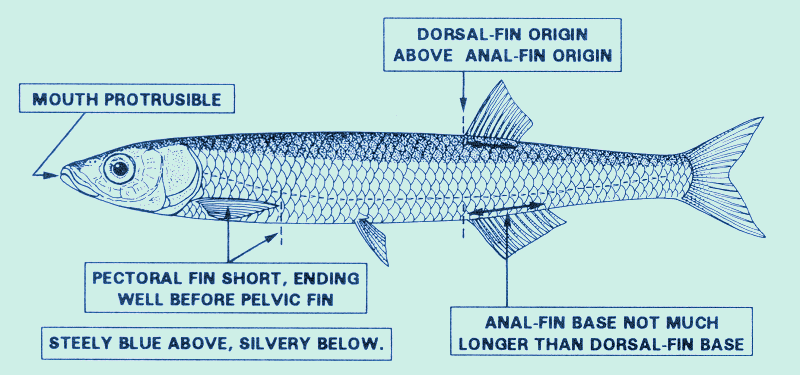

Above: Lake Malawi's famous "Usipa" (Engraulicypris sardella) is a minnow that looks and lives much like an anchovy — a striking example of convergent evolution. It is a slender, shiny, silvery fish that swims in shoals and eats zooplankton. The mouth is toothless and rather large. [Drawing by P. Lastrico, reproduced from Eccles (1992) with the permission of the Food and Agriculture Organization of the United Nations. Slightly modified by moving the mouth label.]The Usipa is Lake Malawi's only true pelagic fish; its larvae have been caught in plankton nets near the surface out in the open lake (Jackson, 1961: 550). Maximum length of adults is 13 cm (5 inches) total length, though it rarely exceeds 10 cm or 4 inches (FishBase; Eccles, 1992).
The classic fisheries report of Bertram et al. (1942: 54) includes the following notes on E. sardella:
It is probably very important in the economy of the lake. It is highly valued by natives — both for food and for bait — and it is at times taken in great quantities in fine nets. It also forms one of the chief foods of the predators in the open water....This fish is said to swim in enormous shoals, both near the shore and far out in the lake. The shoals are often so dense that the fish may be scooped out in large numbers with baskets, hand-nets, or body cloths. It is said that when shoals of Usipa appear all fishing will be good. [However,] very few of these fish and no big shoals were seen by the Survey.
Populations of the Usipa are "r-selected," undergoing "boom and bust" cycles, with "good years" and "bad years" depending on the supply of zooplankton. They can recover rapidly to large numbers after a population crash, presumably when the zooplankton populations likewise return to abundance. When Usipa are numerous, so are the zooplankton-feeding Utaka cichlids (Jackson, 1961). Usipa are a major food of Rhamphochromis cichlids — and also, according to Eccles (1992), of the Usipa's own predatory minnow cousins the "Sanjika" and the "Mpasa" of the genus Opsaridium.
An officer with the UNDP/FAO project at Nkhata Bay told me that the Usipa is thought to be an annual species, living one year (Hans Rufli, personal communication, 1980). Relatively little is known of the biology of this ecologically and commercially important fish. "The spawning site of E. sardella remains a mystery, but is no longer believed to be in the offshore pelagic zone" (Thompson, Allison, & Ngatunga, 1996a). Thompson and Irvine (1997) have studied the diet of its larvae; Thompson (1999) modeled its reproductive rate and survival.

| Last Update: 16 November 2018
Web Author: M. K. Oliver, Ph.D. Copyright © 1997-2021 by M. K. Oliver, Ph.D. - ALL RIGHTS RESERVED |